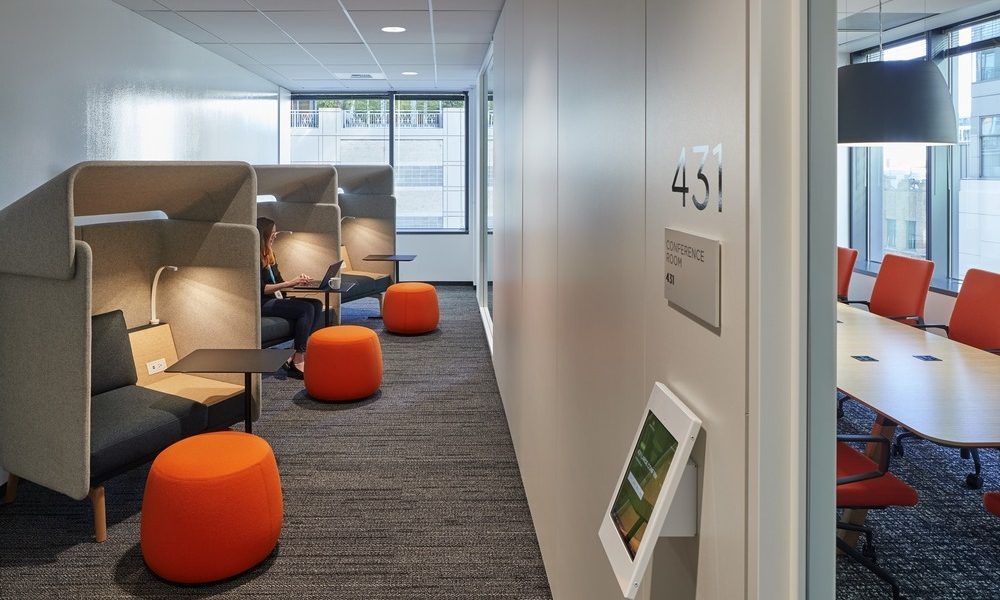 Across multiple floors, flexible new office space was designed for the Seattle Children’s technology team, creating an open-plan layout that fosters cross-team communication and collaboration. Doug Scott Photography.
Across multiple floors, flexible new office space was designed for the Seattle Children’s technology team, creating an open-plan layout that fosters cross-team communication and collaboration. Doug Scott Photography. 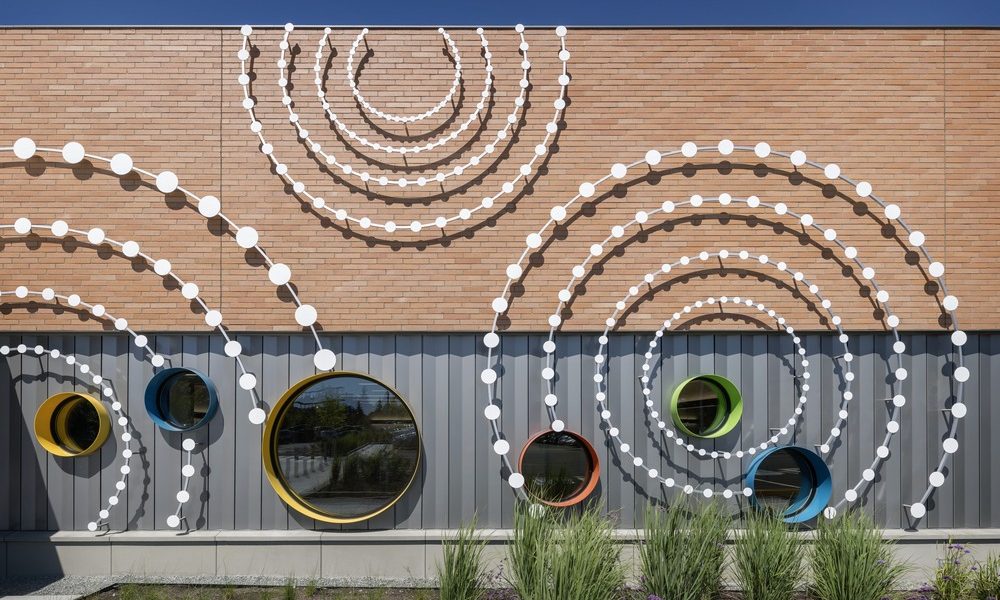 Clad in textured brick, the Seattle Children’s North Clinic shares its design vernacular with the facades of adjacent hospital buildings. A playful twist was put on the brick, resulting in skintled brickwork. The project’s round windows were inspired by droplets of rain that, after landing on glass, reflect light and color. Aaron Leitz Photography.
Clad in textured brick, the Seattle Children’s North Clinic shares its design vernacular with the facades of adjacent hospital buildings. A playful twist was put on the brick, resulting in skintled brickwork. The project’s round windows were inspired by droplets of rain that, after landing on glass, reflect light and color. Aaron Leitz Photography. 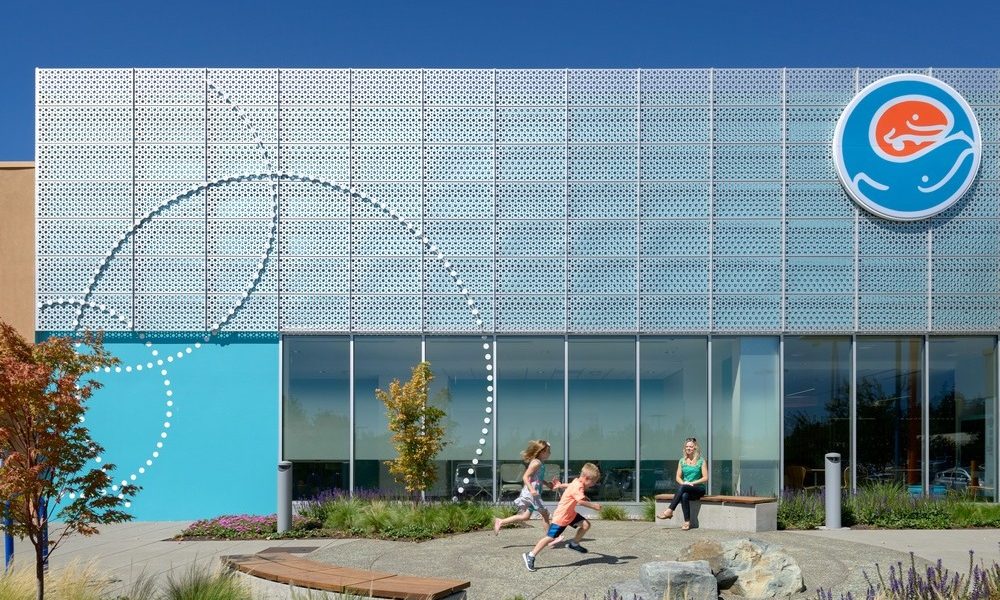 At Seattle Children’s South Clinic, the biophilic site design reflects our intrinsic need to connect with the natural world. Aaron Leitz Photography.
At Seattle Children’s South Clinic, the biophilic site design reflects our intrinsic need to connect with the natural world. Aaron Leitz Photography. 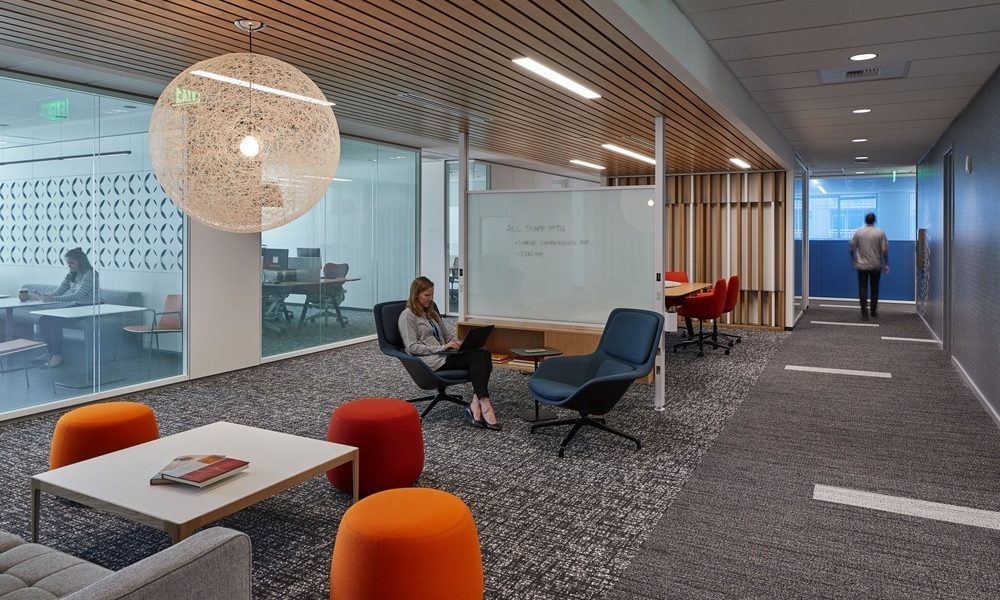 Across multiple floors, flexible new office space creates an open-plan layout that fosters cross-team communication and collaboration. Doug Scott Photography.
Across multiple floors, flexible new office space creates an open-plan layout that fosters cross-team communication and collaboration. Doug Scott Photography. 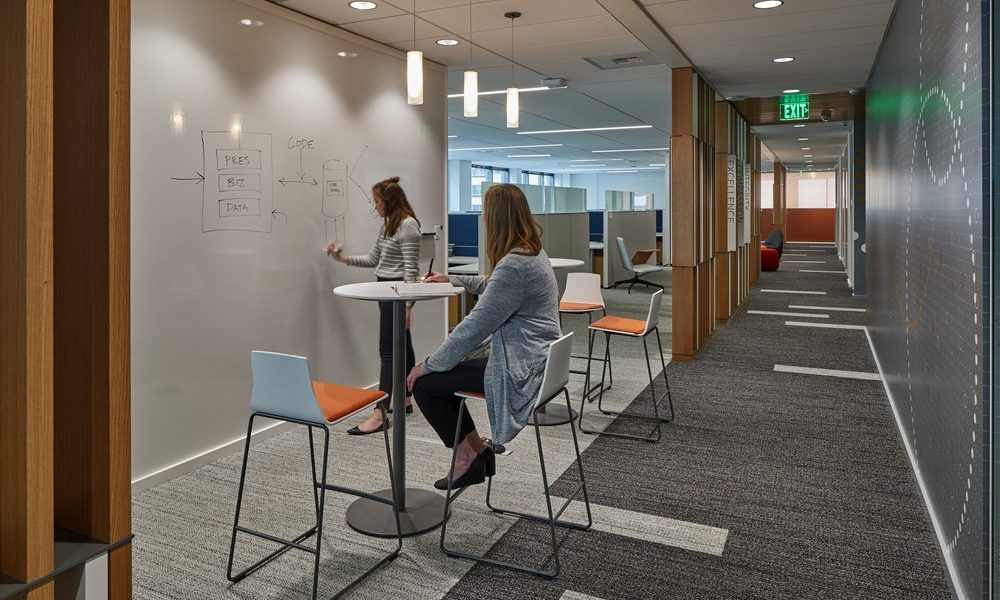 The design team and Seattle Children’s partnered on an administrative master plan for the hospital’s non-clinical departments. Over the next several years, these teams will relocate to six floors of a downtown Seattle high-rise—five miles from the main campus. Doug Scott Photography.
The design team and Seattle Children’s partnered on an administrative master plan for the hospital’s non-clinical departments. Over the next several years, these teams will relocate to six floors of a downtown Seattle high-rise—five miles from the main campus. Doug Scott Photography. Subscribe Now
Weathering Change: 2 Developing Healthcare Trends to Watch in 2020
By Victoria Nichols
At a recent healthcare event in Seattle, Washington, I was joined on stage by fellow panelists from across the AEC industry, as well as a local hospital executive, for a conversation about trends in facility design and construction. Despite the varying nature of our professions and the overwhelming complexity of the industry we all touch—healthcare—two topics continued to surface throughout our discussion.
First, the impact of workforce constraints and shifting worker demographics. And second, how sweeping disruptions are changing consumer expectations.
Winning the battle for talent
One of the healthcare industry’s chief struggles is attracting and retaining healthcare workers and administrative staff. As designers, we have an outsize role (and obligation) to shape facilities that not only elevate the experience of the patients who rely on them, but to meet the varied needs and expectations of multigenerational healthcare employees.
Ideally, this work should begin early, at the master planning level. Amid many competing priorities, prioritizing ample green space, courtyards and therapeutic gardens can ensure that hospital campuses are both patient and provider centered, and that they further the healing taking place inside the care environments. As the acuity level of cases treated on hospital campuses increases, the case for allotting more support space for provider respite, calm and contemplation only grows.
In the workplace realm, the needs of today’s caregivers and support staff are a departure from the work styles and expectations of previous generations. For many of our academic medical center clients, this has required a paradigm shift in the way non-clinical spaces are organized, with a focus on transforming closed, private offices to highly collaborative open-plan environments. This almost always requires cultivating buy-in from multidisciplinary medical staff and leadership and ensuring that all stakeholders feel heard.
To retain and recruit talent, we need to reimagine the healthcare workplace, borrow ideas from beyond healthcare for inspiration—including hospitality and commercial workplace design—and challenge long-held assumptions.
A more collaborative work environment
Many of our clients are engaged in planning their campuses for the next 10, 20 and 30 years. Often, they are situated within constrained urban sites. At the same time, patient populations are projected to expand rapidly.
For Seattle Children’s, this same confluence of events sparked an exploration into how moving non-clinical/administrative functions off campus could free up space for critical clinical functions. The upshot: modernizing its workplaces and optimizing the way teams work together.
Recently, ZGF and Seattle Children’s partnered on an administrative master plan for the hospital’s non-clinical departments. Over the next several years, these teams will relocate to six floors of a downtown Seattle high-rise—five miles from the main campus—for greater space efficiency, abundant natural daylight and views and increased access to restaurants and amenities. All these factors aid in attracting and retaining talent.
Across multiple floors, flexible new office space was designed for the Seattle Children’s technology team, creating an open-plan layout that fosters cross-team communication and collaboration. It also resolves disparities between departments, where previously administrative workspaces ranged from 45 to 250 square feet per person.
The design optimizes existing space to accommodate a wide range of work styles and existing team-wide practices. A mix of daylit workstations, focus and conference rooms of various sizes, designated huddle spaces, large breakout spaces and enclaves for interactive and collaborative work, give users a choice in how and where they work.
Teams are organized into neighborhoods with work points including individual workstations, focus rooms, huddle space and impromptu collaboration space. Centrally located social and meeting hubs, including conference rooms, gathering space and kitchen amenities, encourage teams to meet at the “town center” to collaborate across functions.
At the heart of the administrative master plan is an understanding that cultural change is a necessary part of any growth plan, and that space is a key vector through which cultural change occurs.
Adopting a consumer mindset
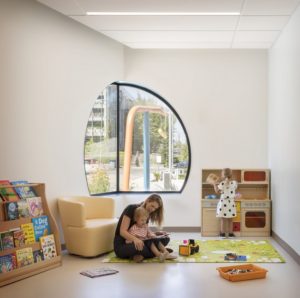
The Seattle Children’s North Clinic includes a siblings room so that parents can be with their children during medical appointments while other siblings. Aaron Leitz Photography.
Through the firm’s work with children’s hospitals around the country, many of the elements that for years have been a hallmark of design are now making their way into the broader healthcare world. The theme underlying them all is the need for organizations to adopt consumer mindsets when addressing the patient experience: wayfinding, moving care closer to where the customers are and planning facilities to meet the needs of not just patients, but their families.
Some of these efforts are faring better than others industrywide. It will be interesting to see how the tech world will approach this problem, as it undoubtedly will. Companies that aren’t traditionally associated with healthcare are entering the fray, including the high-profile new healthcare venture between Amazon, J.P. Morgan and Berkshire Hathaway.
There’s also an untapped opportunity for personalization that truly improves the healthcare experience. To improve the patient and family experience, mobile technology could be better utilized to aid in wayfinding and reduce stress, help them change the tune of their hospital room’s environment to their own liking (temperature, lighting, music) and to keep families abreast of their care plans.
Bringing care closer to the customer
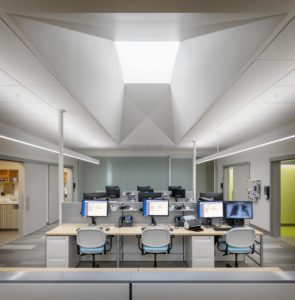
At Seattle Children’s North Clinic, open-plan caregiver work areas are located between patient exam rooms to increase provider interaction and to reduce the number of steps providers need to travel. Staff feedback informed the design of the skylight that brings more natural light to the spaces. Aaron Leitz Photography.
As retail operators continue to struggle attracting both tenants and customers in the ecommerce era, their suburban brick-and-mortar locations present healthcare systems with an opportunity to bring outpatient care closer to their customers—and allow their main campuses to focus on acute care.
For Seattle Children’s and ZGF, this has informed the strategy behind two recently built clinics in the Puget Sound area.
The South Clinic, built in Federal Way, Washington, repurposes an old Circuit City store into a 37,000-square-foot outpatient clinic. It was attractive to both Seattle Children’s and the design team because of its location within an existing retail center—allowing for ample square footage—and existing infrastructure. The lease rates were also compelling.
Adding the South Clinic to the retail center has benefited both the property owner and other tenants. The medical use drives customer traffic outside of the traditional dining and shopping hours. This helps stagger parking demand and provides a steady flow of customer traffic for other businesses. For the property owner, the clinic’s arrival also provides diversity in the tenant mix, an important consideration given the recent volatility in retail real estate.
Lessons learned during the design of the South Clinic project informed the vision for Seattle Children’s North Clinic in Everett, Washington, which debuted in 2018. The clinic was designed with a focus on patient flow to ensure that patients and their families are seen quickly and efficiently. Open-plan caregiver work areas are located between patient exam rooms to increase provider interaction and reduce the number of steps providers need to travel.
We’re working with another client, CHI Franciscan Health, to convert a vacant retail store into a healthcare facility. Slated to open in 2023, a 26,000-square-foot grocery store in Bremerton, Washington, is being transformed into an outpatient clinic. The new facility will also house a residency program for new doctors.
Embarking on a new era
As we speed into the next decade, it’s worth reflecting on the strides we’ve made as an industry in the pursuit of better patient and caregiver environments, and the work still remaining.
One of my favorite parts of the job is hearing from stakeholders—who sometimes number in the hundreds—during the design of a major new facility.
It’s heartening to recall that the little details often mean the most, and can be a source for the biggest impacts.
Author: Victoria Nichols
Victoria Nichols, AIA, LEED AP, is a partner at ZGF Architects’ Seattle, Washington office. Her clients include leading healthcare systems and several of the country’s top children’s hospitals.
Tags: AEC industry, Architecture, Construction, healthcare trends
Posted December 11, 2019
More Articles:
- Coverings 2024
Apr 22, 2024 – Apr 25, 2024 - Hospital, Outpatient Facilities & Medical Office Buildings Summit
Apr 25, 2024 – Apr 25, 2024 - CxA Workshop & Exam
Apr 29, 2024 – Apr 30, 2024 - EMP Seminar & Exam at CxEnergy 2024
Apr 29, 2024 – Apr 30, 2024 - CxEnergy
Apr 29, 2024 – May 2, 2024 - PHCC West 2024
Apr 29, 2024 – May 2, 2024 - Lean in Design Forum 2024
May 1, 2024 – May 2, 2024










